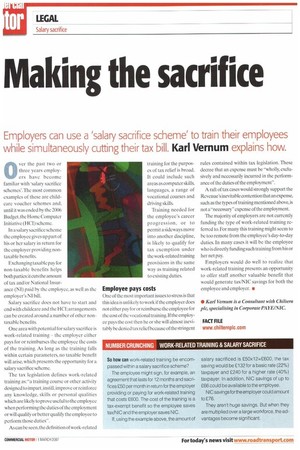Making the sacrifice
Page 40

If you've noticed an error in this article please click here to report it so we can fix it.
Employers can use a 'salary sacrifice scheme' to train their employees while simultaneously cutting their tax bill. Karl Vernum explains how.
0 ver the past two or three years employers have become familiar with 'salary sacrifice schemes'. The most common examples of these are child care voucher schemes and, until it was ended by the 2006 Budget. the Home Computer Initiative (HCI) scheme.
In a salary sacrifice scheme the employee gives up part of his or her salary in return for the employer providing non taxable benefits.
Exchanging taxable pay for non-taxable benefits helps both parties:it cuts the amount of tax and/or National Insur ance (NI) paid by the employee, as well as the employer's NI bill.
Salary sacrifice does not have to start and end with childcare and the NCI: arrangements can be created around a number of other nontaxable benefits.
One area with potential for salary sacrifice is work-related training — the employer either pays for or reimburses the employee the costs of the training. As long as the training falls within certain parameters, no taxable benefit will arise, which presents the opportunity for a salary sacrifice scheme.
The tax legislation defines work-related training as:"a training course or other activity designed to impart. instill, improve or reinforce any knowledge, skills or personal qualities which are likely to prove useful to the employee when performing the duties of the employment or will qualify or better qualify the employee to perform those duties".
As can be seen, the definition of work-related training for the purposes of tax relief is broad. It could include such areas as computer skills. languages, a range of vocational courses and driving skills.
Training needed for the employee's career progression, or to permit a sideways move into another discipline, is likely to qualify for tax exemption under the work-related training provisions in the same way as training related to existing duties.
Employee pays costs
One of the most important issues to stress is that this idea is unlikely to work if the employer does not either pay for or reimburse the employee for the cost of the vocational training. If the employee pays the cost then he or she will almost inevitably be denied tax relief because of the stringent rules contained within tax legislation. These decree that an expense must be -wholly, exclusively and necessarily incurred in the performance of the duties of the employment-.
A raft of tax cases would strongly support the Revenue's inevitable contention that anexpense, such as the types of training mentioned above, is not a -necessary" expense of the employment.
The majority of employers are not currently funding the type of work-related training referred to. For many this training might seem to be too remote from the employee's day-to-day duties. In many cases it will be the employee who is directly funding such training from his or her net pay.
Employers would do well to realize that work-related training presents an opportunity to offer staff another valuable benefit that would generate tax/NIC savings for both the employee and employer.
• Karl Vernum is a Consultant with Chiltern plc, specialising in Corporate PAYE/NIC.
1 FACT FILE www.chi hemp lc.corn


























































































































































































